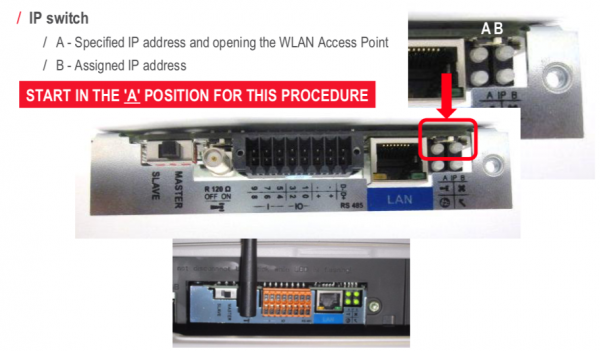Table of Contents
AC-coupled PV with Fronius PV Inverters
This document describes how to setup Energy-storage, Off-grid/Micro-grid and Backup systems with AC-coupled PV, using Fronius PV Inverters.
Victron GX Devices, eg Cerbo GX also include built-in Fronius monitoring.
For Fronius information on the same subject, see their MicroGrid flyer.
A Victron & Fronius training webinar video is available to watch here.
1.1 Frequency shifting
To make sure that the Fronius PV inverter works well with Victron inverter/chargers, both must be configured with the right 'frequency shift settings':
- The Fronius PV Inverter must be set to Setup MG, short for Micro-Grid.
- For off-grid systems, load the Multi or Quattro with the PV Inverter support Assistant
- For on-grid / energy-storage systems, load the Multi or Quattro with the ESS Assistant. Read information about ESS in the design-installation-manual.
And the 1:1 limit rule must be adhered to.
1.2 Fronius / Victron specifics
This is a very easy setup. The Fronius Setup Microgrid has been developed in close cooperation with Victron. During commissioning, set the PV Inverter to Setup MG50 (or Setup MG60 for 60 Hz systems). Everything is then pre-configured. The Setup MG settings match the default Victron Assistant settings.
Compatible ROW inverters (for “European type AC grid”) are:
- Fronius Primo (1~, 3 kW up to 8.2 kW) → Software fro27140.upd or higher (see FAQ Q5!)
- Fronius Symo (3~, 3 kW up to 20 kW) → Software fro27140.upd or higher (see FAQ Q5!)
- Fronius Eco (3~, 25 kW or 27 kW) → Software fro27140.upd or higher (see FAQ Q5!)
- Fronius Agilo (3~, 75 kW up to 100 kW) → Software update19.tl or higher
- Fronius IG Plus V (1~, 2~, 3~, 2.5 kW up to 12 kW) → from IGF 5.0.66 on with settings according to the Victron recommendations
For new systems the Fronius Symo and Fronius Eco inverters are recommended for 3~ applications. The Fronius Primo inverters are recommended for 1~ applications. Please note that all these inverters are transformerless and therefore PV-Modules that require pole-grounding (on the Plus or Minus pole) cannot be connected.
The use of Fronius Galvo inverters is not recommended anymore for new applications - the Fronius Primo is the best substitute and offers higher efficiency, wider DC voltage range and two MPP trackers.
Compatible UL inverters (for “US type AC grid”) are:
- Fronius Primo UL (1~, 3.8 kW up to 15 kW) → Software fro27470.upd or higher (see FAQ Q5!)
- Fronius Symo 10-24 480V (3~, 10 kW up to 24 kW) → Software fro27140.upd or higher (see FAQ Q5!)
- Fronius Symo 10-15 208-240V (3~, 10 up to 15 kW) → Software fro27140.upd or higher (see FAQ Q5!)
For the UL inverters, some more Microgrid Setups are available (e.g. for connection with Neutral conductor or without). Also the UL inverters can be used in 60Hz as well as in 50Hz applications. More information can be found in the user manuals.
When setting up a system, always update both the Fronius and the Victron devices to their latest firmware versions. For the latest Fronius firmware and information how to update use this link: Fronius firmware update
1.3 Setting up the Fronius with Setup MG50/MG60
When not pre-ordered with a MicroGrid setup, follow these steps:
- Make sure that the Fronius PV inverter is updated to at least the firmware version mentioned above. See Inverter list above.
- After making the inverter operational according to the manual, select the language and after this the country specific setup.
- Here choose MG50 or MG60 depending on the system frequency.
- Ready to start up.
1.4 Setting up the Victron Multi or Quattro
- After connecting the MultiPlus or Quattro with the battery, you can now connect a computer through the VE.Bus (in combination with the Victron interface MK2USB) to configure the system with the latest version of the software VE.Configure.
- Go to the tab Assistants:
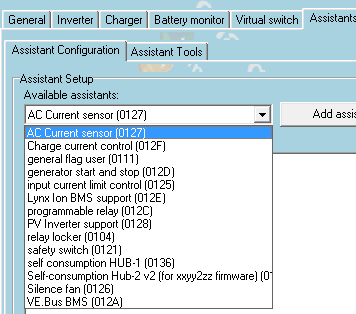
- Add one of the Assistants that regulate output frequency:
- PV Inverter support
- It is not necessary to change the default settings in the Assistant, but please see exceptions below.
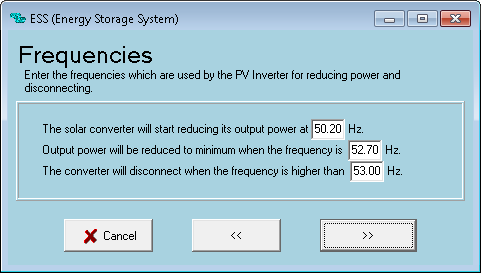
- Complete the rest of the Assistant and write the new settings to the MultiPlus or Quattro.
Table with general suggested settings for 50Hz and 60Hz frequency
| State | 50Hz | 60Hz | . |
| Start | 50.2 | 60.2 | Hz |
| Minimum | 52.7 | 62.7 | Hz |
| Disconnect | 53.0 | 63.0 | Hz |
Note that although the MG50 for instance has a higher start frequency of 51Hz, there is no real drawback using the proposed value of 50.2Hz. The system will just increase the frequency until the PV inverter regulation kicks in. The value of 50.2Hz will work with a broader range of PV inverters/grid codes.
More information on adding Assistants is here.
1.5 Known frequency exceptions
- Fronius bundles between fro35020 and fro36120 (at time of writing) contains a change that holds the inverter relay closed up to 53Hz for grid code MG50, or 63Hz for MG60. This sometimes causes problems when reconnecting to the grid. Please set the Disconnect frequency to 53.1Hz/63.1Hz for these versions. Consult the Fronius changelog when in doubt.
2. GX Devices & Fronius PV Inverters
By connecting a Fronius PV Inverter and GX device (eg Cerbo GX) together you will be able to:
- See Fronius information on the GX Device.
- Monitor the Fronius on the VRM Portal.
- Allow the Victron system to control the Fronius output power, Zero feed-in. See the ESS manual, chapter 2.1.3 Fronius Zero feed-in for details.
This document describes how to setup the monitoring functions.
2.1 Requirements
| Model | Required accessory |
|---|---|
| Fronius Symo Light | Purchase and install the datamanager 2.0 |
| Fronius Symo | No accessory needed, datamanager card installed from factory |
| Fronius Galvo | No accessory needed, datamanager card installed from factory |
| Fronius Primo | No accessory needed, datamanager card installed from factory |
| Fronius Eco | No accessory needed, datamanager card installed from factory |
| Fronius IG Plus (*) | Purchase and install the datamanager 2.0 |
| Fronius Agilo | Purchase and install the datamanager box |
| Fronius GEN24 | See here for limitations and GEN24 special procedure |
(*) The Fronius Zero feed-in feature - which is part of an Energy Storage System ESS - will work on all the above models except the IG Plus.
All recent Fronius inverters - for example the Fronius Primo - will arrive fitted with a datamanager 2.0, as standard.
Both the Fronius and the GX Device need to be connected on the same LAN - either via Wi-Fi or Ethernet.
Note that the Datalogger Web is not supported. Contact your Fronius dealer to find out about the upgrading options.
2.2. Configuring
2.2.1 Setup Local Area Network (LAN) Configuration
In order to establish a data communication between the Fronius and the GX Device, you will have to setup a valid LAN IP address on the Fronius, using one of the following methods. If you are in doubt, which method is the best for your network, please ask your system administrator or IT support.
2.2.1.1 DHCP addressing method
If you have a DHCP server running on the LAN the Fronius and GX Device are connected to, you don't need to manually configure your LAN IP addresses as the DHCP server does this for you. Make sure, that the “IP Switch” is in “B” (default) position on the datamanager, to allow the Fronius to obtain it's IP address. It can be reviewed in the Address Lease Table of the DHCP server.
2.2.1.2 Link-local addressing method
When no DHCP server is present on the LAN and you only have one Fronius unit to connect, Link-local addressing can be used to establish data communication between the GX Device and the Fronius. This could be the case, if you use a WiFi Network for the GX Device to gain access to the Internet and have a Fronius connected to the wired LAN Interface of that GX Device.
Note, that no direct access to the internet will be possible for the Fronius in that configuration and therefore only communication to the GX Device is possible.
This method can only be used to configure a single Fronius unit within a LAN. Multiple Fronius devices in the same LAN must be configured with DHCP, or manual addressing method.
- Connect both, the Fronius and the GX Device, on the same LAN network, either directly with a LAN cable or using a network switch.
- The Fronius is now accessible and having a “Link-local” capable IP address configured: 169.254.0.180
2.2.1.3 manual addressing method
You will have to configure the IP address of the Fronius to be in the same subnet as the IP address of the GX Device. To do this, first have a look at the IP configuration your GX Device is using on that network.
The IP configuration can be reviewed in Settings –> Ethernet. The important settings are the IP address and Subnet Mask.
If the LAN IP address and Subnet Mask of the GX Device is not configured yet, you will have to set it first.
As an example, the IP address on the GX Device could be: 192.168.10.1 and the Subnet Mask: 255.255.255.0.
Configuring the Fronius to the same subnet means setting a manual IP address to: 192.168.10.2 and the same Subnet Mask of 255.255.255.0 on the Fronius.
Every device on your LAN has to have a unique (different) IP address and so the last segment (.1/.2) in this example has to differ on every device on the same LAN. The highest value, that can be set for this segment is 254.
The subnet is described by the first 3 segments in this case and so they have to be the same. Configuring multiple devices with exactly the same IP addresses will lead to network errors. Use different IP subnets for the WiFi and wired LAN interface. The IP address ranges used on each interface should differ in the third segment.
As an example: 192.168.10.1-254 for LAN IP's and 192.168.11.1-254 for WiFi IP's.
Configure the Fronius Datamanager to use an IP address on the same subnet, as described above. You may need to refer to the Fronius operating manual for how this is done for your Fronius Inverter model,
If you would like to connect the Fronius to be able to use the internet connection of your Local network, you have to set Gateway and DNS IP addresses on the Fronius as well. They should be exactly the same as in the Settings –> Ethernet of the GX Device.
2.2.1.4 special procedure for GEN24 model
In Fronius GEN24 devices with software version 1.14 or higher, the Solar API interface is not activated by default and must be activated if required (e.g. integration of a GX device).
The setting for this can be found on the user interface of the Fronius inverter under “Communication” - “Solar API”.
For GEN24, there is no physical toggle switch required (as there is with other models).
Victron and Fronius have made no tests, nor make any claims about the performance of this integration. If light flickering issues occur, please contact your Fronius dealer.
2.2.2 Adding Fronius to the GX Device
1. In the GX Device, navigate to Settings and then the PV Inverters section. You will see this menu:
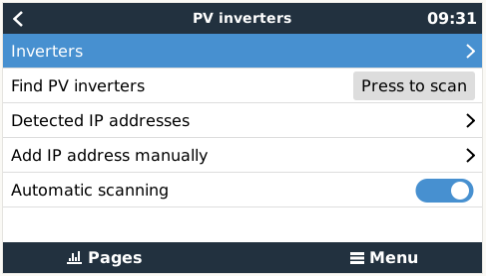
2. Select Scan in the GX Device menu, and after completion go into the Inverters submenu to see the results. If scanning does not find the inverter, manually add the IP address of the Fronius Datamanager from its card, or box.
3. The GX Device will automatically scan for PV-inverters on the local network if no PV-inverters were found previously or if a previously-found PV-inverter cannot be contacted. This will happen if the IP address of the PV-inverter changes. To prevent automatic scanning, disable Automatic scanning.
- We recommend that automatic scanning is enabled (the default) in residential and small commercial applications.
- In larger installations, or where the scanning interferes with other equipment on the network, automatic scanning should be disabled.
- Note that if DHCP is used to allocate dynamic addresses in your computer network, the connection to your PV-inverter may be permanently lost if automatic scanning is disabled and the IP-address of the PV-inverter changes.
4. Once located, you will see the Inverters listed in the menu. The name used will be the serial number of the inverter - which you will also find on the inverter itself:
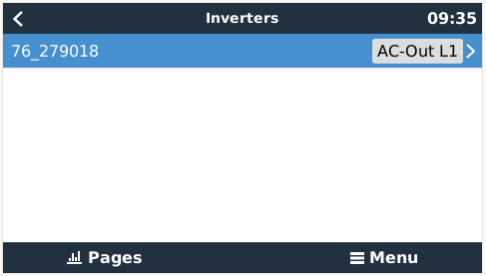
5. Configure the position relative to the Multi or Quattro (is it: AC Input / AC Output); and the show setting for each inverter in the list:
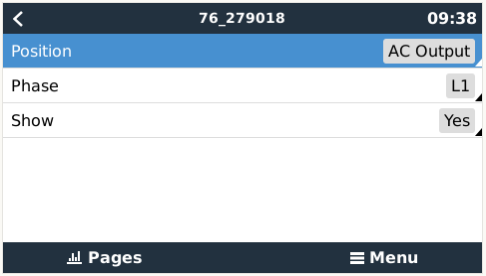
- Position: Select the position relative to the Multi or Quattro [AC Input 1 / AC Input 2 / AC Output]
- Show: Select whether to how this inverter in the system or not. Use this feature when there are multiple, separate, energy systems on the same LAN.
6. Configure the phase for each inverter in the list:

- Phase: Select the phase on which the PV Inverter installed. This setting is automatically set to Multi-phase for split- and three-phase PV Inverters.
- In some cases a single-phase PV inverter may deliver power at 240V or 208V across two downstream phases, such as in a residential split-phase configuration in North America. In this case the setting will not be set to Multi-phase automatically and you need to select Split-phase (L1+L2). This instructs the GX Device to divide the measured incoming power evenly across the two phases for display and accounting purposes.
7. Done!
2.2.3 Device scan details
As mentioned above the GX Device should find all Fronius inverters automatically. It will scan all IP-addresses in the local network (that is, all IP-addresses within the netmask assigned to the GX Device) to check whether or not they are Fronius datamanager cards. This scan will be performed during GX Device startup; whenever the GX Device loses connection to a data card; and a scan can also be initiated manually by selecting 'Press to scan'.
Usually a scan is completed within a minute - though if you have a large subnet it may take much more time. If you don't want to wait for completion, enter an IP-address manually.
All data cards found will be entered in the 'Detected data cards' list. The GX Device will regularly (once every minute) scan the IP-addresses in this list in order to find new data cards, or reconnect to data cards whenever the connection was lost.
If you don't want an automatic scan to be performed, disable the Automatic scanning setting on the PV-inverters menu.
2.3 Monitoring GX Device
When the Fronius is detected and configured on the GX Device all PV inverters will be visible in the devicelist.
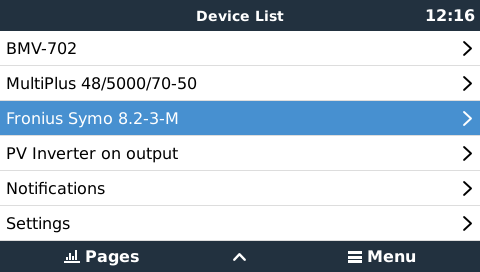
To see the device details, navigate to the menu.
Here you can see the current state, current power generated, total power generated.
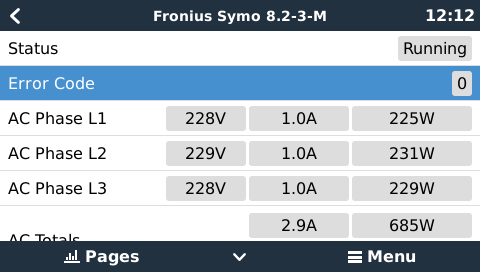
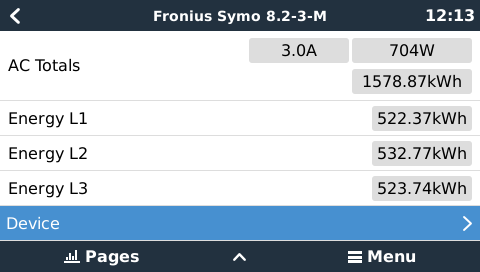
For more details on each device navigate to the Device menu. Here you will find: IP address, Product name, product ID, and Serial number, etc.
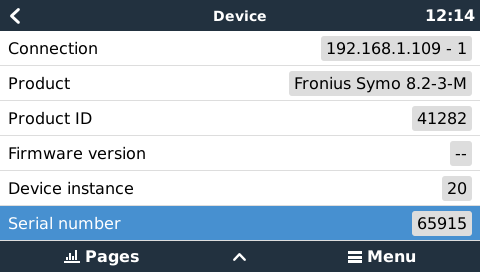
Inverter status
The following status values are supported:
| State | Meaning |
|---|---|
| Standby | The PV-inverter is not generating power. |
| Startup | The PV-inverter is starting up, but not generating power yet. |
| Running (MPPT) | The PV-inverter is running at maximum power. |
| Running (Throttled) | The PV-inverter is running, but power is being throttled. |
| Error | One or more errors are present. Note that not all errors will cause the PV-inverter to shut down. |
2.4 Monitoring on the VRM Portal
To see the yield on the VRM site (in the Advanced tab), don't forget to enable the PV Inverter yield widget(s) in Settings → Advanced tab setup.
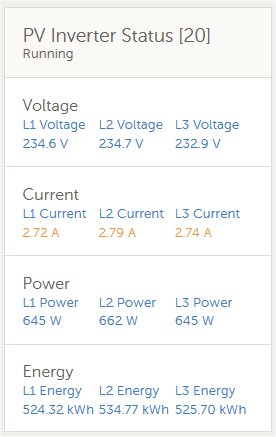
2.5 Zero Feed-in
It is possible to make a Zero feed-in system with Victron & Fronius. The Venus device will the control the Fronius output power. See the ESS manual, chapter 4.3.13 - AC-Coupled PV - Zero and Limited Feed-in with Fronius AC PV for details.
3. Frequently Asked Questions
Q1 Why doesn't the frequency settings in the Multi and the Fronius need to be the same?
The first two frequencies do not need to be the same since the Multi actively regulates.
Q2 I have an Fronius IG inverter (not Plus), can that work?
No, the IG inverters cannot be made to work in a MicroGrid system. The appropriate substitute for an IG 30 is the GALVO 2.5-1 or an IG Plus 25V-1 (depending on the desired DC voltage range).
Q3 The system is locked to 53 Hz and does not resume
See here.
Q4 Can I use the Fronius Smart Meter?
That depends on the type of system and software configuration.
A Fronius Smart Meter can be used in these two situations:
- when used only for reporting to Solarweb
- when used for limiting export, in a system where the Victron system is not configured as an ESS system.
The Fronius Smart-Meter can not be used for the Fronius built-in export limiting feature when part of a Victron ESS system. Instead, use the Victron ESS Fronius Zero-feed in feature, see chapter 4.3.11, Fronius Zero Feed-in, in the ESS manual.
Q5 How can I get the Fronius firmware that improves flickering?
Fronius has a special firmware available, on request, that fixes light flickering issues that occur on certain installations under certain circumstances.
For Fronius PV inverters produced after 2018-week 16, contain the flicker-fix already straight from production.
To update earlier and/or already installed PV Inverters, contact Fronius Tech Support for the file. The required file is fro29130.upd. Which works for all snap-inverter models (Primo, Symo and Eco). There is no, and will be no, fix available for Fronius Galvos.
Q6 What do I do if my Fronius PV-inverter is detected as Unknown PV-inverter, or Multiphase, or cannot be configured as 3-phase?
Later Fronius PV-inverters support both the Fronius SolarAPI- as well as the industry standard SunSpec protocol. When SunSpec is not available the GX device cannot properly detect the properties of the PV-inverter unless it is one of a fixed list of known older models. Newer PV-inverters will then show up as Unknown, and you will not be able to configure them as 3-phase.
The solution is to configure SunSpec support on the PV-inverter.
- Log into the Fronius web interface.
- Go to the Modbus tab
- Set Data export via Modbus to tcp.
- set Sunspec Model Type to int + SF
 Add this page to your book
Add this page to your book  Remove this page from your book
Remove this page from your book  Manage book (
Manage book ( Help
Help 
